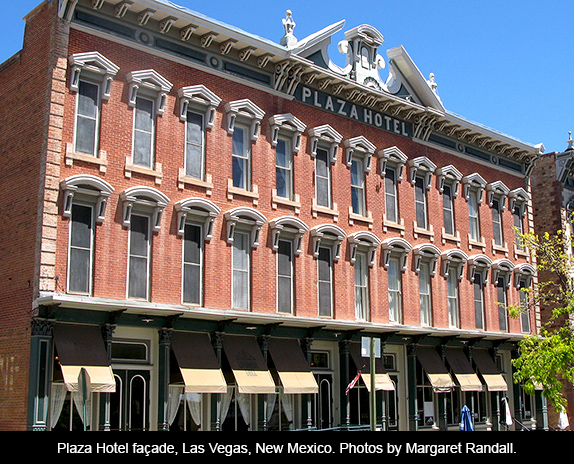
There’s a rumor that the people who did such a successful renovation of Mary Elizabeth Colter’s La Posada Hotel in Winslow, Arizona, will be signing the papers to take over the old Plaza Hotel in Las Vegas, New Mexico on July 4, 2014. The Plaza first opened its doors in 1882 along one flank of the town’s main plaza and, with brief exceptions, has continuously served the area since. Like La Posada, it holds memories of the grand era of the railroad, when trains brought easterners and others west. Each of these hotels, in its unique way, provided comfort and elegance to travelers exploring a new frontier.
Although modern settlement dates to the 1850s, Las Vegas’ importance rose when the Atchison, Topeka & Santa Fe Railroad arrived in 1879. A train depot was built just across the Gallinas River from the Plaza Hotel. This was when “New Town” (also called East Las Vegas) began to take shape, with its sprawl of buildings, bars and other businesses.
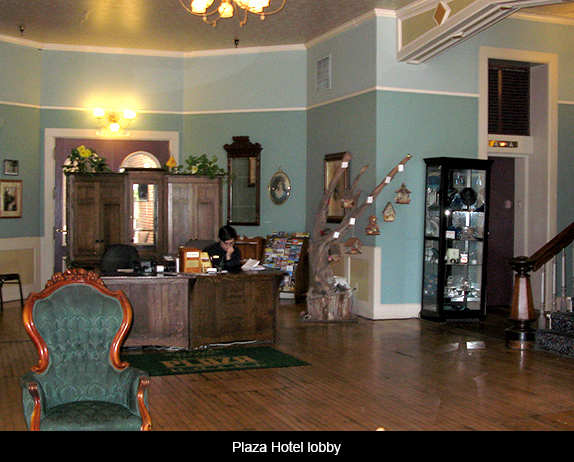
Driving home from Colorado recently, we stopped at the Plaza for lunch. Its Landmark Café serves excellent food at very reasonable prices. Accompanying us in the dining room was a recruiter wining and dining a prospective football player, a few other tourists, and several locals. The café décor follows the theme in lobby and stairwells, evoking a 19th century when Europe was the reference for elegance and that elegance met hammered tin ceilings and Wild West paraphernalia with considerable grace.
In 1882, Las Vegas was becoming one of the West’s commercial centers. Don Benigno Romero and Jean Pendaries spent $25,000 building the hotel—a lot for the era—but it closed four years after completion due to hard times and mismanagement. It wasn’t until 1886 that the hotel reopened and it hasn’t closed since. Seventy-two rooms house guests, and the restaurant and bar cater to their watering needs. Over the years, one main addition and several upgrades improved the original structure.
As long as the railroad was America’s main manner of travel, the hotel prospered. And so did the city. At the turn of the twentieth century an economic downturn and a railroad strike depressed the economy, closing much commerce throughout the New Mexico Territory. Las Vegas’ Victorian era came to an end. It would be more than a decade before the era of silent films raised Las Vegas’ fortunes once again. In 1913 the hotel was briefly renamed Hotel Romaine, after Romaine Fielding who was the nation’s most popular movie star at the time. Tom Mix also made and directed a number of films in and around Las Vegas; the Plaza can be seen in several.
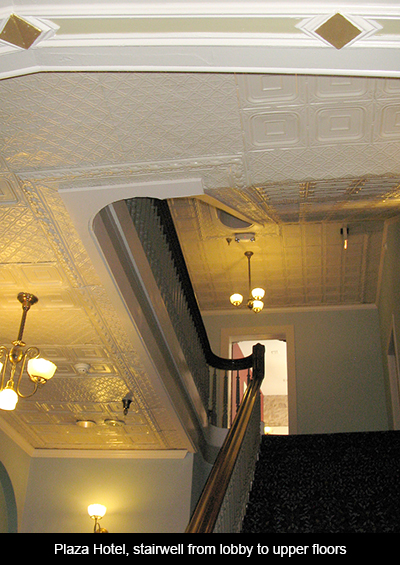
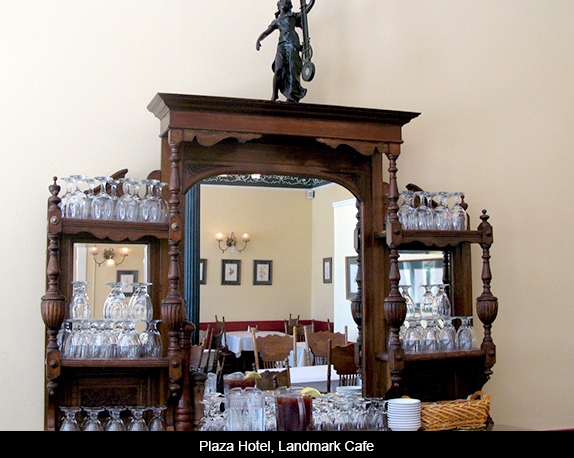
The Plaza’s restaurant and bar were the scenes of a good deal of political discussion during the 1970s. In 1982, Lonnie and Dana Lucero—who owned the hotel at that point—joined Wid and Katherine Slick in a partnership to bring the Plaza back to its former glory. This particular reconstruction took thirteen months and approximately two million dollars. The US Department of the Interior and New Mexico State Historic Preservation Office joined the effort, and the hotel reopened in December. Today the site includes a ballroom with full banquet facilities, meeting rooms, an exercise facility and an underground Rathskellar.
Las Vegas itself is worth a visit. It is unique among New Mexico cities and, in contrast with many, shows visible signs of new energy. Highlands University is just one of a number of thriving endeavors with long and fascinating histories. Many artists make Las Vegas their home; their work can be seen in galleries as well as in the city’s public art. Walking around the central plaza, interesting architectural details catch your eye every few feet. Two larger than life size statues—one a female figure, the other male—dominate the scene. The day we were there a group of young skateboarders were showing off their skills atop the central bandstand.
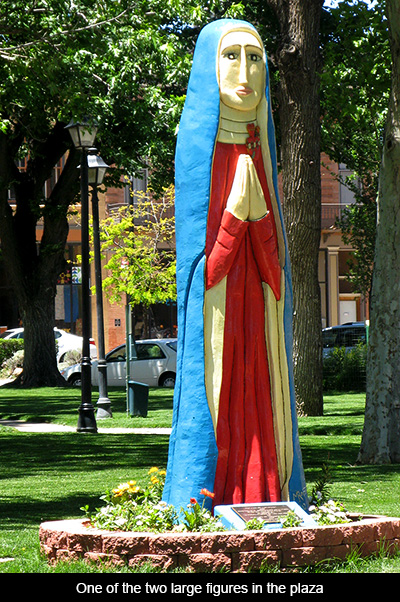
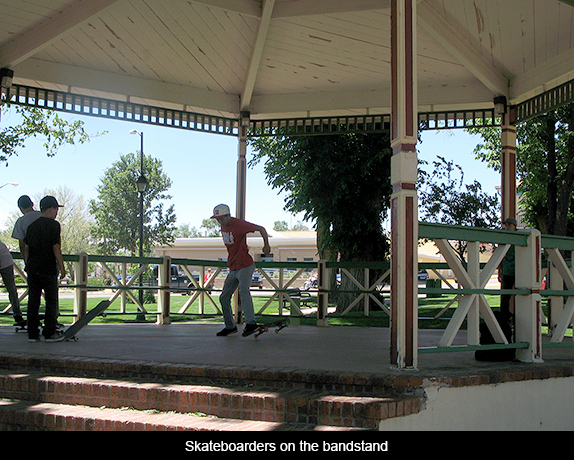
This northern New Mexico city combines strong Anglo and Spanish traditions. Historically, the people of Las Vegas have supported their community culture, from the Spanish immigrants’ neighborhood fiestas to an opera house and social and literary clubs.
Along with this cosmopolitan atmosphere, it was also known as one of the rowdiest cities in the West, with more than its share of infamous gamblers, colorful outlaws and “lost” women (the euphemism for prostitutes). There was a time when it rivaled Dodge for crime.
As is so often the case, the area’s Indian history is less well known, although it is believed that another luxury hotel, the Montezuma, got its name from the fact that the Aztec emperor once journeyed north to the hot springs, long known for their health-giving waters.
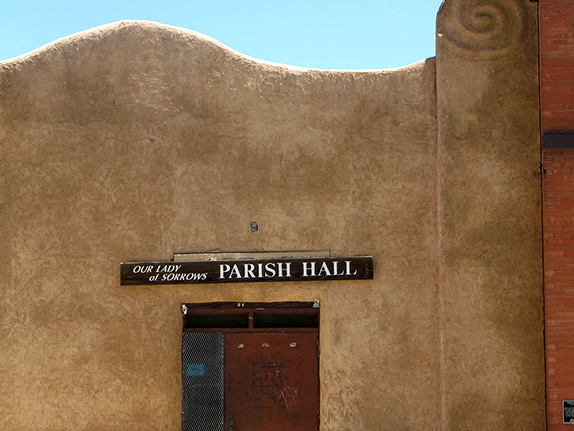
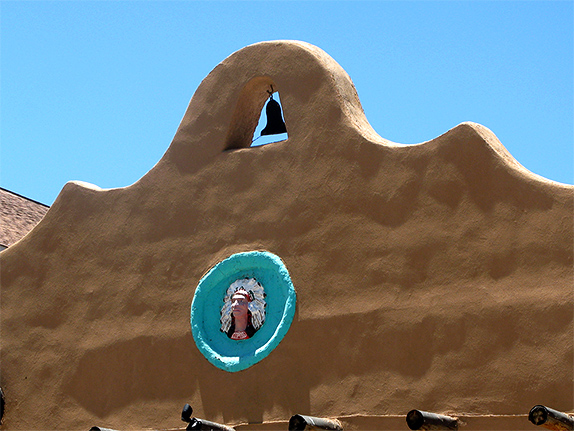
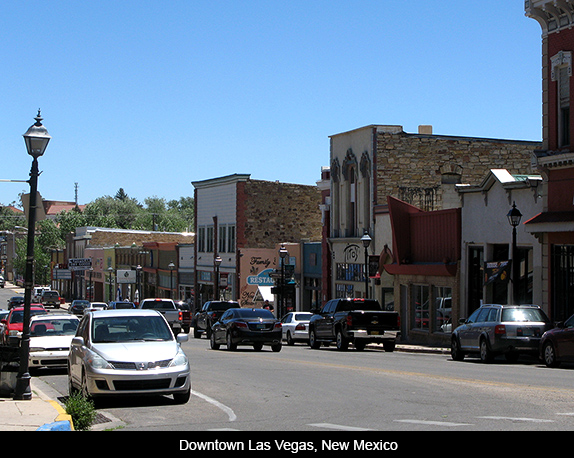
Today—unlike so many places throughout the state and country—Las Vegas, New Mexico is enjoying an industrial and historic revitalization. Retaining its architectural particularities and character, it is very different from cities such as Santa Fe or Taos. It is nothing like Albuquerque or Las Cruces either. One of our state’s great virtues is its diversity. Las Vegas has its own niche.



Responses to “Friday Voyage: The Old Plaza Hotel, Las Vegas”